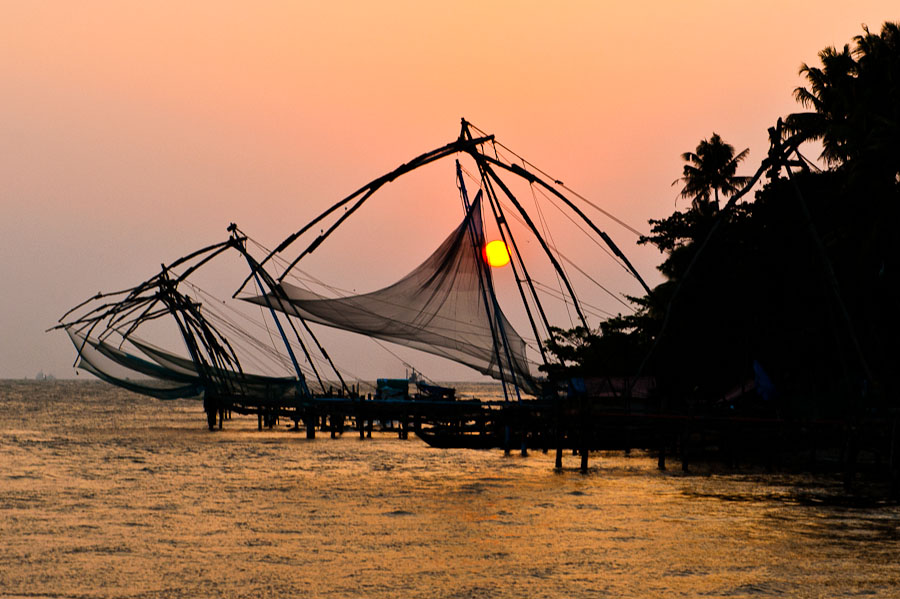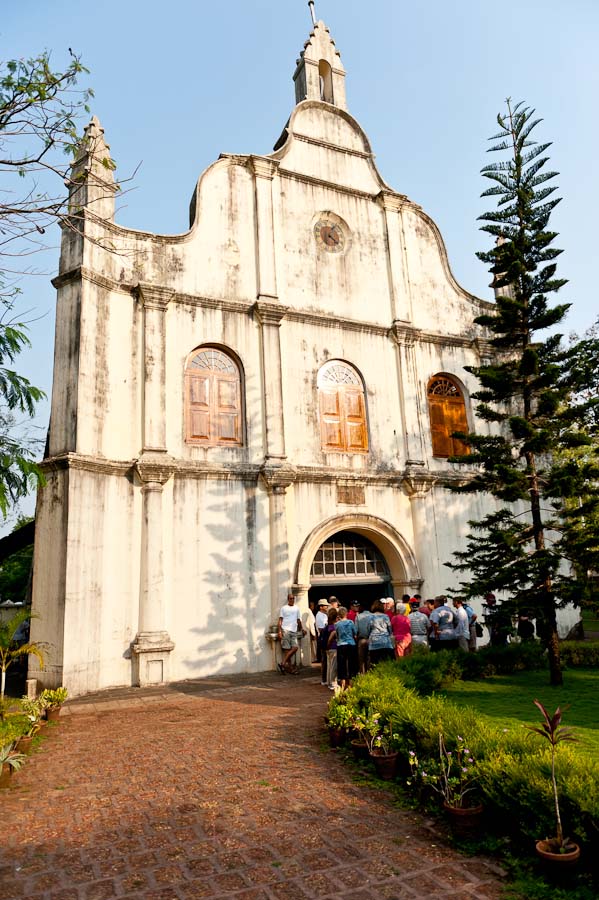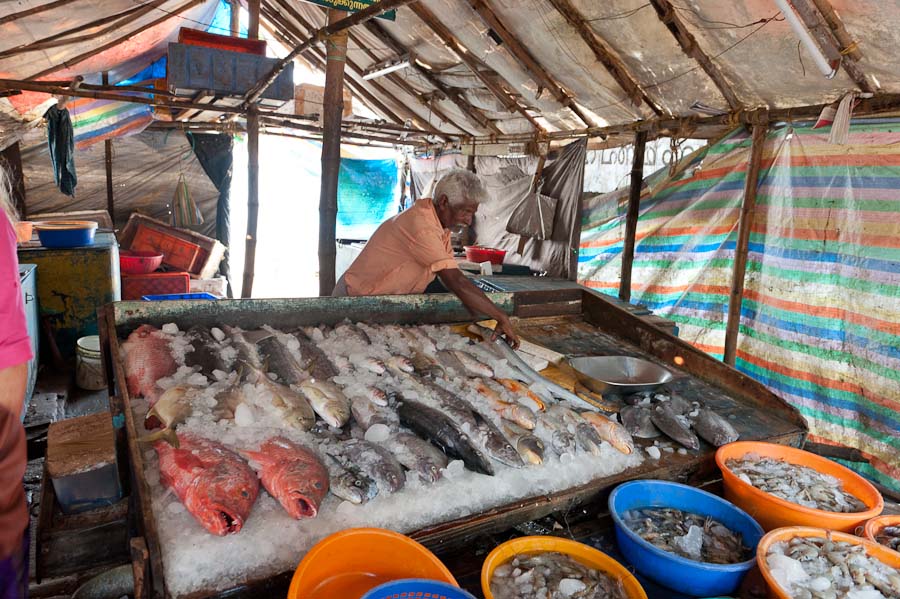Under a bright white sky with a thick humid haze along either side of the harbor entrance, we arrived at noon into Cochin, India. Within an hour of arrival, we were off the ship and onto a bus for a multi-phased tour designed to introduce us to the area and take us on a sunset boat tour of the harbor area.
Click here for the detailed Cochin Day 1 Photo Gallery.
Cochin is a port city located on the Southwest part of the Indian peninsula. The name Cochin means “like (co) China (chin)”, meaning the early settlers felt it was a place similar to China. The port is located on Willingdon Island which is a man-made island created when Vembanad Lake was dredged to form the current harbor.
As an introduction to Cochin (also called Kochi) it is known as the Queen of the Arabian Sea and is considered by some to be the finest natural harbor in the world. It has a cluster of islands on the vast expanse of the Vembanad Lake and was the first location settled by explorers in this area.
Because of its commercial importance, foreign powers vied for supremacy in the area over a long period of time leaving in their wake several exotic cultures like the Portuguese, Jewish, English, French, Dutch and Chinese making this an interesting place to visit.
As we drove from the port it was hard to miss the massive piles of sand and the large number of colorful, uniquely painted trucks that were there to take loads of it to some unknown location. In fact, the port area was awash in sand. We left the island and drove to Old Kochi, witnessing the Tuk-Tuks and typical Indian retail establishments mixed in among some interesting buildings built over the past several hundred years
Our first stop was the Mattancherry Palace, also known as the Dutch Palace, which is a two-story building with covered porch areas overlooking an interior courtyard. It has intricate carved wood ceilings and detailed paintings on the wall that are amazingly preserved. The Dutch carried out some extensions and renovations in the palace in 1663, and thereafter it was popularly called the Dutch Palace.
There was no photography allowed on our room-by-room tour of the Palace. It was hot, cooled only by an occasional fan. We were sweating by the time we emerged 30 minutes later to the swarm of ever-present persistent wandering sales people who were selling silk scarves, carved wooden statues and other local items.
They had an optional tour of Paradesi Synagogue that is close to the Dutch Palace. There used to be hundreds of Jews in this area and they built the synagogue in 1568. Upon the foundation of Israel, all but a few Jews migrated out of Cochin. The alleys outside the Palace are still called Jew Town and we had a few minutes to shop in the shopping area which had restaurants, typical vendor stands and fairly nice retail stores carrying all manner of goods.
There is also a Hindu temple in-between the Palace and the synagogue. In fact, they share a common wall. We would learn throughout India about the religious tolerance and, in fact, the manner in which they revel in the celebration of other’s religious celebrations. It seems that there is one big party going on most of the time!
Next we took a short drive to the St. Francis Church. The church has a colorful past, it was started as a wooden church inside the original Fort Kochi in 1498 by the Portuguese and rebuilt in stone and masonry in 1516. The church was run by the Franciscans until the Protestant Dutch took over in 1663. This church was the only one that wasn’t demolished. In fact it was improved and converted into a government church. In 1795, the British came in but allowed the Dutch to retain the church until they relinquished it to the Anglicans in 1804, giving it the current name.
Next, we took a short bus ride to a retail store that sold high end carpets and clothing and used the restrooms and, sweating quite a bit, we then walked to the Chinese fishing nets and fish market for a 30 minute walk-a-bout.
The Chinese fishing nets, which have been in place since the 1,500’s are fixed land installations for an unusual form of fishing — shore operated lift nets. They are mostly found in the Indian state of Kerala. Huge mechanical contrivances hold out horizontal nets about 60 feet or more across. Each structure is at least 30 feet high and comprises a cantilever with an outstretched net suspended over the sea and large stones suspended from ropes as counterweights at the other end. Each one of these nets are operated by a team of up to six fishermen.
The Chinese fishing nets have become a very popular tourist attraction, their size and elegant construction is photogenic and the slow rhythm of their operation is quite hypnotic. In addition, catches can be purchased individually and need be taken only a short distance to a street entrepreneur who will cook it. The fish market is located along the street and consists of several haphazard structures with fish laid out in informal manner, some in ice, some just sitting in the heat. The fish were small in size but larger fish such as snapper, grouper and some the size of tuna were also available. Several cats were hanging out and it seemed a popular thing for the fish stand operators to feed them some fish scraps to draw in tourists for pictures. Of course, they expected a small payment for the privilege. The cats were some of the happiest kitties we’ve seen…pretty good life for a Cochin kitty!
The last, and best, part of our tour was to take a houseboat on a 45-minute tour of the harbor. We glided past numerous fishing boats that were returning at the end of the day with their catch. There was a ferry taking people over to a small island covered with palm trees and we were treated to a beautiful sunset. A German cruise ship was departing as we made our way back toward the port. We disembarked the houseboat and were back on the bus for a short ride to the Voyager.
In the evening, a local group put on a Kathakali dance performance. To make a long story short, two men spend hours putting on makeup. In our case they did this in the atrium of the Voyager next to the coffee bar. About 30 guests were taking pictures of them along the way. One many dresses up with yellow face makeup, ending up being a pudgy woman, the other ends up with dramatic costume, headdress and curved white cardboard glued to his face. The dance is silent, short of continuous drums and a speaker telling you what is going on. The yellow-faced “woman” demonstrates emotions via hand motions and on and on. It really seemed like a comedy show more than anything. This is very popular in Kerala where it originally started. Most of is found it pretty strange.



.jpg)



Cheryl - WOW… I love the photo of the fishing nets at sunset. You need to frame that. Just beautiful!
Trip Summary » Travel with Dale & Margaret - […] Cochin, India […]